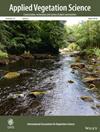Livestock species rather than grazing intensity shape plant guild proportions in interaction with multiple environmental drivers in grassland from the Pyrenees
Abstract
Questions
- Does grazing management shape the proportion of plant guilds (grasses, legumes, forbs and sedges) in mountain grasslands?
- Which properties of grazing management have the greatest effect on the proportion of plant guilds: grazer diversity/identity or grazing intensity?
- Are the effects of grazing management on guild proportion modified by other environmental variables that explain plant guild distribution at broad spatial scales?
Location
Mountains in the Pyrenees.
Methods
We modelled the proportion of grasses, legumes, forbs and sedges using data from the PASTUS database (n = 96), which contains a wide range of environmental and management conditions due to the high variety of environmental conditions in mountain grasslands in the Pyrenees. We used a machine-learning algorithm to find those variables that best explained the proportions of each plant guild. We focussed on the differences between the levels of grazing intensity and the grazing species included in the model, and on detecting interactions between grazing variables and climate, topography and soil conditions.
Results
The proportion of forbs and grasses strongly depended on the grazing livestock species at broad spatial scales. Only soil pH showed a higher overall explanatory power on guild distribution. In general, forbs were favoured in cattle- and grasses in sheep-grazed grasslands, the latter also being favoured on acidic soils, while forbs were favoured in more alkaline soil conditions. However, the effects of those factors (grazing species and soil pH) were modulated through interactions with several other environmental variables, including soil Mg, K and P, and terrain slope. In contrast, grazing intensity was a minor driver of guild distribution.
Conclusions
Our results provide information about the relationship between plant functional diversity, indicated by the different plant guild proportions, and grazing management in the Pyrenean grasslands. This information could be useful for developing hypotheses for future experimental studies and for designing policies to improve the management of mountain grasslands.

 求助内容:
求助内容: 应助结果提醒方式:
应助结果提醒方式:


